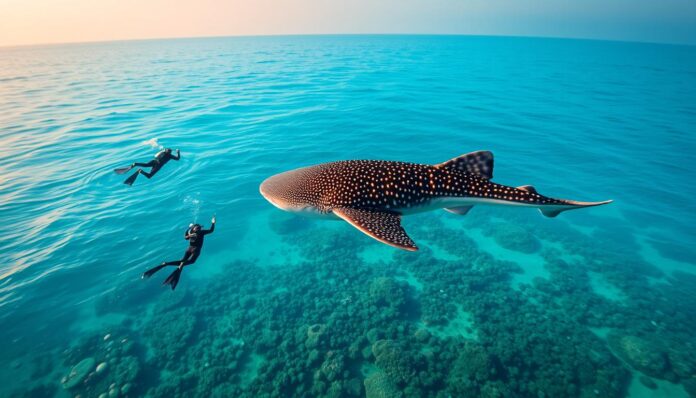Imagine seeing the world’s largest fish, a whale shark up to 12 meters long, while diving. These gentle giants offer an unforgettable scuba diving experience. It’s a chance to see these amazing creatures up close.
Meeting whale sharks turns ordinary dives into special moments. These huge fish are harmless to people and mostly eat tiny plankton. They are truly nature’s wonders.
Swimming with whale sharks is a unique adventure. You can do it in places like the Maldives or Mexico’s Sea of Cortez. The best times are between June and October, when they are most active.
Key Takeaways – Diving with Whale Sharks
- Whale sharks can grow up to 12 meters in length
- Best diving seasons run from June to October
- Completely safe for human interaction
- Found in multiple global marine locations
- Unique opportunity for underwater photography
- Suitable for beginners and experienced divers
Introduction to Whale Sharks and Scuba Diving
Ocean adventure travel lets you explore the world of marine life. Whale sharks are a top choice for those who love swimming with gentle giants.
These amazing creatures have been in our oceans for about 60 million years. They can grow up to 18 meters long, making them the biggest fish in the sea.
What are Whale Sharks?
Whale sharks are huge marine animals with unique spots. They are peaceful and eat small fish, plankton, and tiny sea creatures.
Why Go Scuba Diving with Them?
Diving with whale sharks is a special experience. It turns regular ocean trips into unforgettable adventures. You get to see these gentle giants up close and take amazing photos.
- Breathtaking underwater photography
- Intimate wildlife encounters
- Personal connection with marine ecosystems
“Swimming alongside a whale shark is like encountering a living, breathing prehistoric marvel that connects you directly with the ocean’s profound mysteries.”
Best Times to Dive with Whale Sharks
When to see whale sharks depends on their migration and where you are. Knowing their seasons helps plan your trip.
| Region | Best Months | Water Temperature |
|---|---|---|
| Cozumel, Mexico | May-September | 24-26°C |
| Ningaloo Reef, Australia | March-July | 22-25°C |
| Maldives | August-November | 27-29°C |
Conservation note: Responsible diving practices help protect these magnificent creatures, whose global populations have declined by over 50% in recent decades.
Top Destinations for Whale Shark Diving
Choosing the right spot for whale shark diving is key. These gentle giants offer amazing experiences. They turn your dreams into lasting memories.
Whale sharks can be found in many amazing places worldwide. Each spot offers a chance to see these creatures up close. It’s a way to connect with them while protecting their home.
Asia:
- Maldives: The Maldives is renowned for its stunning coral reefs and abundant marine life, including whale sharks. South Ari Atoll is a popular hotspot for encountering these majestic creatures.
- Philippines: The Philippines offers multiple locations for whale shark encounters, with Donsol in the Bicol Region and Oslob in Cebu being notable destinations known for their resident populations.
- Mozambique: The waters of Tofo Beach in Mozambique are frequented by whale sharks, offering divers the opportunity to swim alongside these gentle giants while exploring the vibrant coral reefs.
- Seychelles: The pristine waters of the Seychelles are home to a variety of marine species, including whale sharks. Diving around the remote Aldabra Atoll provides a chance to encounter these magnificent creatures.
- Mexico: Isla Holbox and Isla Mujeres in Mexico’s Yucatan Peninsula are popular destinations for whale shark encounters. These areas provide a unique opportunity to swim alongside these majestic creatures during their annual migration.
- Belize: Gladden Spit in Belize is known for its whale shark aggregation during the full moon in the months of March to June. Divers can witness these gentle giants feeding on the spawning aggregations of fish.
- Honduras: The Bay Islands of Honduras, particularly Utila and Roatán, are frequented by whale sharks. Divers can experience thrilling encounters while exploring the vibrant reefs of this Central American paradise.
- Costa Rica: Cocos Island, a UNESCO World Heritage site, is an exceptional destination for encountering whale sharks. This remote and pristine location offers divers the chance to experience these gentle giants in a unique and breathtaking setting.
- Maltese Islands: The waters surrounding the Maltese Islands in the Mediterranean Sea occasionally attract whale sharks during their migration. While sightings are rare, divers have been fortunate enough to encounter these magnificent creatures in this region.
- Ningaloo Reef, Australia: Ningaloo Reef, located in Western Australia, is one of the most renowned destinations for swimming with whale sharks. Each year, between March and July, these gentle giants gather in large numbers, providing an incredible opportunity for close encounters.
- Papua New Guinea: Divers visiting Milne Bay in Papua New Guinea may be lucky enough to encounter whale sharks. This remote and pristine diving location offers a unique chance to witness these magnificent creatures in a less crowded setting.
- Hawaii, USA: The Hawaiian Islands are occasionally visited by whale sharks during their migratory journeys. While sightings are infrequent, encounters with these majestic creatures have been reported, particularly around the island of Maui.
- Galapagos Islands, Ecuador: The Galapagos Islands, famous for their rich biodiversity, are occasionally visited by whale sharks. These islands offer a unique opportunity to encounter these gentle giants while exploring the unique ecosystem that inspired Charles Darwin’s theory of evolution.
It’s important to note that whale shark sightings can vary depending on the time of year, local environmental conditions, and migratory patterns. Planning your dive trip during the peak season for each destination increases your chances of encountering these magnificent creatures.
When visiting these destinations, it’s crucial to choose reputable dive operators that prioritize responsible and sustainable interaction with whale sharks, ensuring the well-being of the animals and their natural habitat.
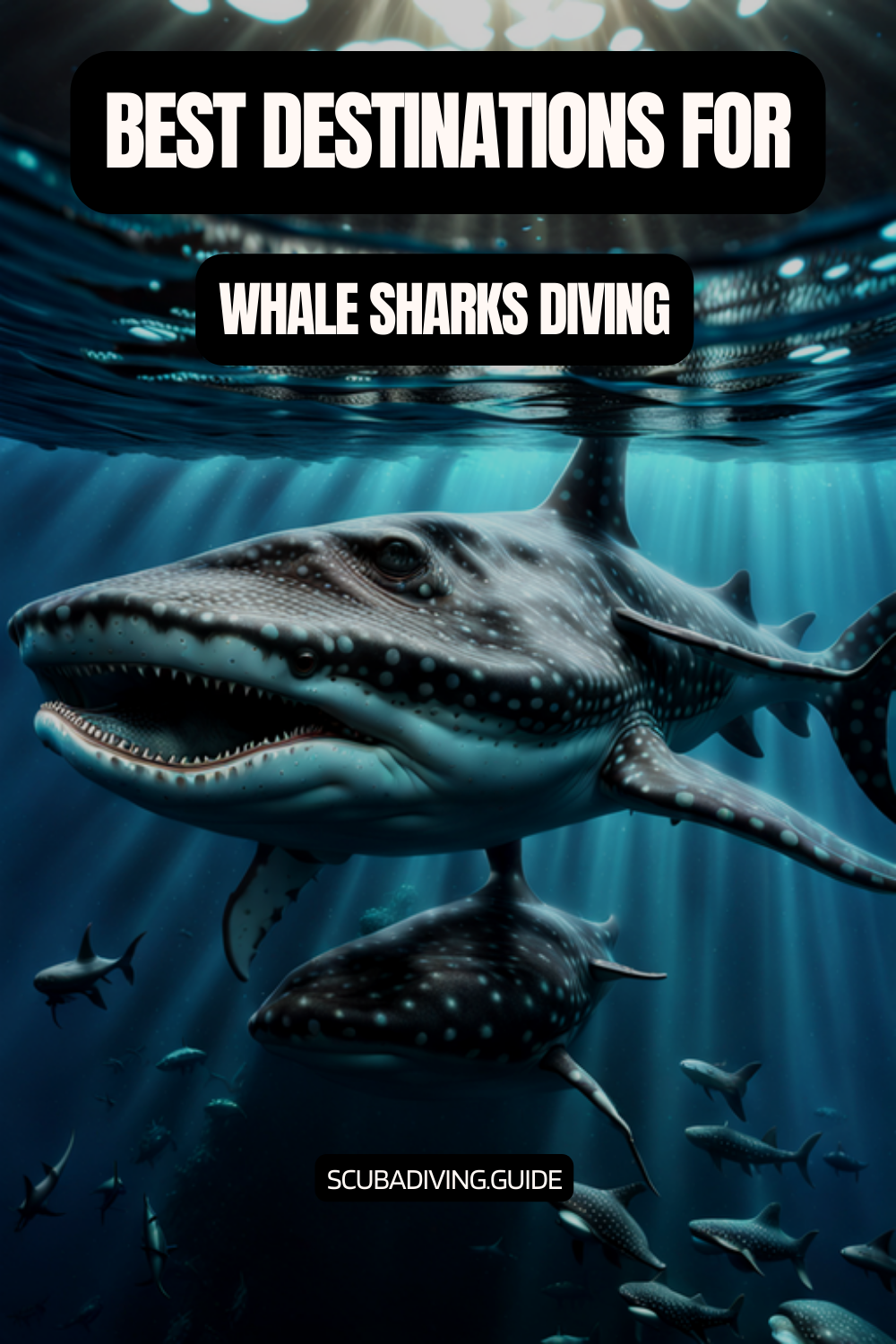
“Diving with whale sharks is not just an adventure, it’s a profound connection with the ocean’s most magnificent creatures.”
These places are the best for seeing whale sharks responsibly. They give travelers a chance to see these giants in their natural home. It also helps support conservation efforts.
What to Expect During Your Dive
Going on a dive with whale sharks is an exciting adventure. These gentle giants let you see marine life up close. It’s an experience you won’t forget.
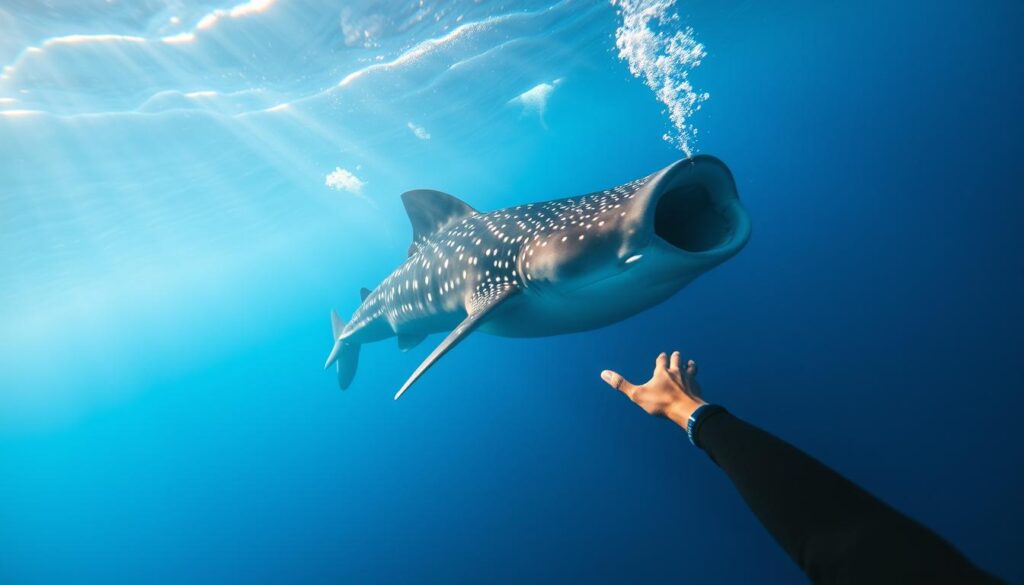
Diving with whale sharks is like watching the biggest fish in the ocean. They can be up to 40 feet long. Seeing them underwater is truly amazing.
The Dive Experience
Your dive will take you into a world of wonder. Whale sharks swim slowly, so you can watch them closely. Here are some key things to see:
- Observe their unique spotted patterns
- See how they filter feed
- Feel their calm, peaceful movement
Safety Precautions to Consider
“Respect the ocean, respect the whale shark, and you’ll have an incredible experience.” – Marine Biologist
Keeping safe is important when diving with marine life. Here are some rules to follow:
- Stay at least 3-4 meters away
- Move slowly and avoid sudden actions
- Never touch or chase the whale shark
Environmental Guidelines to Follow
Responsible diving helps protect whale sharks and their home. Divers play a big role in keeping them safe.
| Guideline | Purpose |
|---|---|
| No flash photography | Prevent disturbing marine life |
| Use reef-safe sunscreen | Protect marine ecosystem |
| Do not feed whale sharks | Maintain natural behavior patterns |
Remember, your dive is not just an adventure, but an opportunity to connect with and protect these magnificent marine creatures.
Equipment Needed for Scuba Diving with Whale Sharks
Getting ready for a dive with whale sharks means picking the right gear. The right equipment makes your dive with whale sharks unforgettable. It turns a simple trip into a memorable experience.
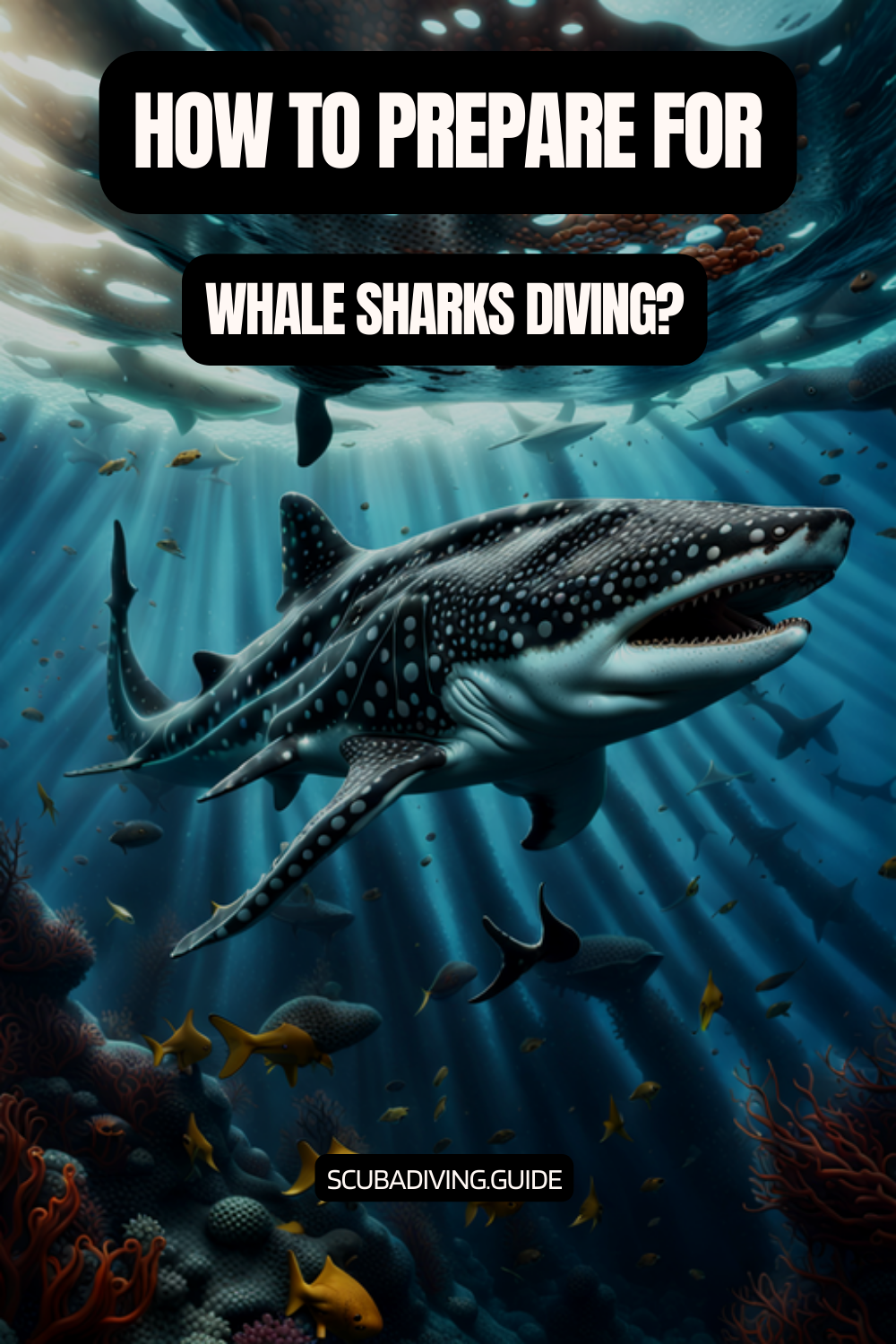
Essential Gear for Your Adventure
For a successful whale shark dive, you need the right stuff. Your essential gear includes:
- High-quality mask with wide peripheral vision
- Comfortable wetsuit (3-5mm thickness)
- Reliable dive fins for efficient underwater movement
- Professional-grade regulator set
- Dive computer with depth and time tracking
Rental vs. Personal Equipment
Deciding between renting or buying depends on how often you dive. If you dive rarely, renting is a good choice. But if you dive a lot, buying your own gear is better. It ensures you always have what you need.
“The right equipment transforms an ordinary dive into an extraordinary adventure.” – Marine Exploration Society
Specialty Equipment for Whale Shark Encounters
Take your dive to the next level with special gear:
- Underwater camera with wide-angle lens
- Buoyancy control device (BCD) with optimal adjustment
- Underwater communication devices
- Dive lights for low-visibility environments
Choosing the right gear for sustainable diving is key. It lets you explore the ocean without harming it. This way, you can enjoy your dive while protecting the sea.
Staying Safe While Diving with Whale Sharks
Diving with whale sharks is a unique experience that requires respect and knowledge. It’s a chance to see these gentle giants up close. This experience is safe and helps protect the ocean.
It’s important to know how whale sharks behave. They travel long distances, making each meeting special. This shows how vital it is to dive responsibly.
Understanding Whale Shark Behavior
Whale sharks are calm, but divers need to keep their distance. Here are some key things to remember:
- Keep at least 3 meters away from the whale shark
- Stay 5 meters back when they’re feeding vertically
- Avoid sudden movements to not scare them
- Don’t touch or block their path
Avoiding Common Mistakes
Some divers make mistakes that can harm both themselves and the whale shark. Here are things to avoid:
- Never chase or follow the whale shark
- Keep noise and movements calm
- Listen to marine experts’ advice
- Drive boats at 10 knots or less near whale sharks
Emergency Protocols Underwater
“Calm and controlled actions are your best defense in any unexpected marine situation.”
In emergencies, divers should:
- Stay calm and avoid panicking
- Slowly go back to a safe spot (reef or boat)
- Signal to your buddy right away
- Use agreed-upon emergency signals
By following these tips, divers can have safe and memorable times with whale sharks. It also helps protect the ocean for future generations.
The Best Season for Diving with Whale Sharks
Planning your ocean adventure travel means knowing when whale sharks migrate. These amazing creatures offer incredible experiences all year. Each season brings something special, making your encounters unforgettable.
Global Whale Shark Migration Patterns
Whale sharks can be found worldwide all year. This gives travelers a chance to see the world’s largest fish. They can grow up to 18 meters, making underwater experiences truly magical.
Peak Seasons by Region
- Mexico (Baja California): January and November peak seasons
- Belize (Gladden Spit): March diving opportunities
- Australia (Ningaloo Reef): March through August
- Mexico (Isla Holbox): July peak season
- Galapagos Islands: August and September prime months
- Tanzania (Mafia Island): October and November
Seasonal Considerations for Whale Shark Diving
Knowing the seasons is key for great whale shark encounters. Water temperature, plankton, and local ecosystems affect their movements.
“The ocean is a world of wonder, and whale sharks are its most extraordinary ambassadors.” – Marine Biologist Research Team
| Month | Top Destinations | Encounter Probability |
|---|---|---|
| January | Baja California, Mozambique | High |
| March | Belize, Australia, Thailand | Medium-High |
| July | Isla Holbox, Mexico | Very High |
| August-September | Galapagos Islands | Excellent |
| October-November | Mafia Island, Tanzania | Good |
For ocean adventure travel tips: Always check local marine conditions. Work with certified tour operators for the best whale shark experiences.
Photography Tips for Capturing Whale Sharks
Underwater whale watching is a thrilling chance for photographers. It lets them capture the beauty of the ocean’s largest fish, the whale shark. These creatures can grow up to 40 feet long, making them a unique subject for photos.
Camera Equipment Recommendations
Choosing the right camera gear is key for amazing whale shark photos. Here are some top picks:
- For DSLR cameras: Tokina 10-17mm fisheye lens for crop sensors
- Full-frame cameras: Sigma 15mm or Canon 8-15 circular fisheye
- Compact cameras: UWL-04 fisheye lens
- GoPro models (Hero 3, Hero 4) for high-quality underwater shots
Techniques for Underwater Photography
Underwater photography needs special skills and techniques:
- Use ambient light to minimize equipment
- Aim for optimal aperture settings (f8 for compact, f18 for mirrorless)
- Practice freediving to capture various angles
- Capture unique behaviors like the vertical “botella” feeding position
Best Practices for Ethical Photography
“Respect the marine environment and the whale sharks while capturing their majestic beauty.”
When taking photos of these gentle giants, remember to:
- Maintain a safe distance
- Avoid using flash or disturbing their natural behavior
- Prioritize the whale shark’s comfort over getting the perfect shot
Pro tip: Use a selfie pole like the SeaLife Aquapod to minimize direct interaction while capturing incredible images.
Conservation Efforts for Whale Sharks
Whale sharks are a key marine species facing big challenges in our changing oceans. They have lost over 50% of their population in the last 30 years. This shows how urgent it is to support responsible ecotourism and sustainable diving.
Current Threats to Whale Shark Populations
Environmental pressures are making marine wildlife interactions harder. The main threats to whale sharks are:
- Overfishing and bycatch
- Habitat destruction
- Climate change impacts
- Disrupted migration patterns
Divers Supporting Conservation
Scuba lovers can help protect these amazing creatures in important ways:
- Choose eco-friendly diving operators
- Join citizen science projects
- Support research efforts
- Keep marine interactions minimal
Organizations Protecting Whale Sharks
Many organizations are working hard to save whale sharks:
| Organization | Primary Focus | Key Contribution |
|---|---|---|
| Global Whale Shark Program | Research and Protection | 100% of donations support conservation |
| Maldives Whale Shark Research Programme | Long-term Species Study | Ongoing research from 2006 |
| Galapagos Whale Shark Project | Scientific Exploration | Advanced tracking and biological studies |
“Every dive is an opportunity to become a guardian of our marine ecosystems.” – Dr. Simon Pierce, Whale Shark Research Expert
By choosing responsible marine wildlife interactions, divers can help save these incredible creatures for the next generations.
Personal Experiences and Testimonials
Diving with whale sharks turns simple bucket list dreams into unforgettable oceanic adventures. These incredible creatures provide an adrenaline-filled experience that leaves divers amazed and inspired.
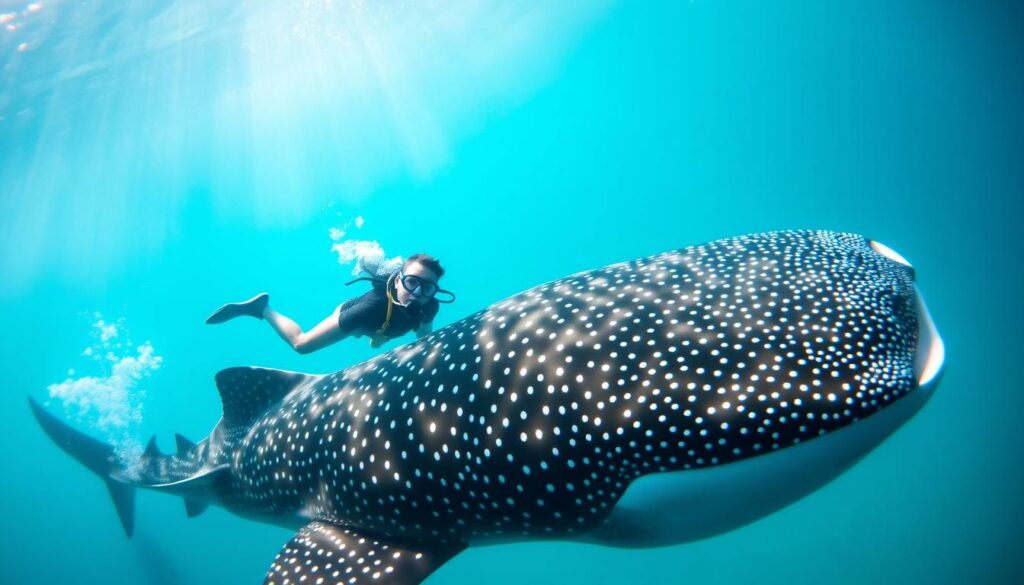
Memorable Encounters: Scuba Divers’ Stories
Whale shark encounters are more than just dives. They are life-changing moments of connection with the sea. Divers from all over the world share amazing stories of swimming with these gentle giants.
“Everything is bigger in the Galapagos, and the whale sharks are no exception! Swimming with these gentle giants was an incredible experience, seeing 40-50 foot long whale sharks that were nearly double the size of those I’ve encountered elsewhere.”
Tips from Experienced Divers
Seasoned whale shark divers share tips for an unforgettable dive:
- Choose destinations during peak migration season (November to June)
- Book with responsible charter companies
- Maintain a respectful distance from the sharks
- Use underwater photography techniques carefully
- Prioritize marine conservation
Inspiring Conservation Stories
Many divers turn their whale shark encounters into a drive for conservation. Understanding these creatures are endangered motivates many to become ocean ambassadors.
They learn about the sharks’ role in marine ecosystems and support protection efforts. Whale shark encounters inspire a deeper love for our planet’s marine life and a commitment to protect it.
Common Marine Species Found Alongside Whale Sharks
Diving with whale sharks often provides the opportunity to encounter a diverse array of marine species that coexist in their habitats. These encounters add an extra layer of excitement and wonder to the overall diving experience. Let’s explore some of the common marine species that can be found alongside whale sharks:
- Remoras: Remoras, also known as suckerfish, are commonly seen hitching a ride on the body of whale sharks. These slender fish have a unique adaptation that allows them to attach themselves to the skin of larger marine animals using a suction disc on top of their heads. They benefit from this symbiotic relationship by gaining protection and access to food scraps while providing a cleaning service to the whale sharks by removing parasites.
- Manta Rays: Manta rays are often spotted in the same locations as whale sharks, as they share similar feeding grounds. These graceful creatures, with their impressive wingspans and elegant movements, create a breathtaking spectacle alongside the whale sharks. Witnessing the interaction between these two gentle giants is a truly mesmerizing experience that showcases the richness of marine biodiversity.
- Tuna and Jacks: Schools of tuna and jacks are frequently seen swimming alongside whale sharks, particularly in areas where there is an abundance of food. These fast-swimming fish take advantage of the same planktonic blooms or baitfish schools that attract the whale sharks. Their agile movements and synchronized behavior create a vibrant and dynamic underwater scene.
- Triggerfish: Triggerfish, with their vibrant colors and distinctive shapes, are often seen darting in and out of the coral reefs that serve as feeding areas for whale sharks. These curious and territorial fish can add a splash of color and activity to the dive, creating an exciting contrast to the calm presence of the whale sharks.
- Sea Turtles: Sea turtles are another common sight during whale shark dives. These ancient reptiles are known for their graceful swimming style and are often found foraging on the same food sources as the whale sharks. Observing sea turtles gliding through the water alongside the gentle giants adds a sense of tranquility and natural harmony to the underwater experience.
- Various Fish Species: Alongside the more prominent marine species, a variety of smaller fish can be found thriving in the presence of whale sharks. Surgeonfish, angelfish, parrotfish, and butterflyfish are just a few examples of the colorful and diverse fish species that populate the reefs and accompany the whale sharks during their feeding activities.
Encountering these diverse marine species alongside whale sharks highlights the interconnectedness and richness of marine ecosystems. The presence of such a diverse array of species serves as a reminder of the importance of preserving and protecting these fragile habitats.
Conclusion and Call to Action
Scuba diving with whale sharks is an amazing ocean adventure. It turns regular vacation memories into unforgettable treasures. These huge marine animals, up to 12 meters long, let us connect with nature’s gentle giants.
Seeing whale sharks is more than just a trip. It supports marine conservation. Places like Mexico, the Philippines, and Thailand have eco-tourism. It protects these animals and helps local communities.
Your Underwater Journey Awaits
Diving with whale sharks is more than a dive. It’s a chance to learn, be inspired, and connect with marine life. Whether you’re a pro or new to diving, it offers moments of wonder and growth.
Embrace the Adventure
Start your ocean adventure today. Look for good dive operators and join conservation efforts. Get ready for a journey that will change how you see marine life. Your whale shark adventure is waiting—dive in!
FAQ – Diving with Whale Sharks
Are whale sharks dangerous to humans?
No, they’re not! Whale sharks are gentle giants. They’re huge but don’t harm humans. They let divers swim with them peacefully.
How big do whale sharks actually get?
They can be up to 40 feet long and weigh 20 tons. Each one has unique white spots, like human fingerprints.
What equipment do I need for whale shark diving?
You’ll need a good wetsuit, mask, fins, snorkel, and maybe a camera. Dive operators often have gear, but experienced divers like their own.
Where are the best locations for whale shark encounters?
Great spots include Mexico’s Isla Holbox, the Philippines’ Donsol Bay, Australia’s Ningaloo Reef, and Honduras’ Isla Roatan. Each place has its best times for seeing whale sharks.
How close can I get to a whale shark?
Stay about 10-15 feet away. Getting too close can stress them. It’s important to respect their space and enjoy watching them.
When is the best time to dive with whale sharks?
It depends on where you go. Mexico is good from June to September. Western Australia’s Ningaloo Reef is best from March to July. Always check the local migration times.
Are whale shark diving tours environmentally responsible?
Yes, good operators follow eco-friendly practices. They teach about marine conservation and help protect these amazing creatures.
Do I need advanced diving certification?
Basic snorkeling skills are enough for many encounters. But, advanced certification can be helpful. Some places welcome both beginners and experienced divers.
How much does a whale shark diving experience cost?
Prices range from $100 to $500. It depends on where you go, how long you stay, and what’s included. Look for deals and group rates to save money.
Are whale sharks endangered?
Yes, they’re endangered. Threats include fishing, pollution, and habitat loss. Responsible tourism is key to protecting them.
